According to wikipedia.org, “blue cheese” is a “general classification of cow’s milk, sheep’s milk or goat’s milk cheeses that have had Penicillium cultures added so that the final product is spotted or veined throughout with blue, blue-gray or blue-green mold and carries a distinct smell.”
As I mentioned when I reviewed the Rogue Creamery Blue Cheeses, these cheeses don’t do much for this feline foodie but The Lady and The Man are big fans and The Lady suggested I review a few for you. I have agreed but will not give any of the cheeses my signature “Paw” designation…similar to the AOC, PDO, DOP designations given to European cheeses…but better, of course…
First a brief history of blue cheese.
It is believed that “blue” cheese was discovered by accident (as was cheese in general). Cheese was aged in caves, which were temperature and moisture controlled. The moisture, in particular, was conducive to the growth of many molds and “blue” most likely was one that grew well in that environment. The earliest known blue cheese was Gorgonzola in the 9th century AD; followed by Roquefort in the 12th century. Stilton is a “late-comer”; having come along in the 18th century.
Gorgonzola, Roquefort and Stilton are blue cheeses, which like wine and other agricultural products carry the “PDO” (protected designation of origin) stamp of the EU. Additionally, France protects Roquefort; Italy protects Gorgonzola and England protects Stilton. As I have discussed elsewhere in this blog, protected cheeses can only bear the name if they are made in a particular region or a country following strict guidelines for production.
An interesting bit of trivia: The bacterium brevibacterium linens which gives blue cheese its pungent smell is the same bacteria that causes human foot odor…who knew??? Every once in a while The Lady says that customers make the comment that certain cheeses smell like dirty socks…now you know why…
In alphabetical order, here are many of the blues that The Lady sells at the Cheese Kiosk:
Bleu d’Auvergne.

Well-respected French Cheesemaker, Antoine Roussel in the middle part of the 19th Century, created this cheese. Again, it was an “accident” that helped Roussel develop this cheese. He noticed that blue molds on his curds created a pleasant taste. He began experimenting with methods to give his cheese blue veins. After several failures, he discovered that rye bread mold did the trick and when he pricked the curd with a needle, the mold entered the cheese and grew successfully.
This cheese boasts the French AOC protection.
Today it is pricked using mechanical needles and is aged in wet, cool caves for between four to eight weeks.
The Man likes this blue better than The Lady as it is stronger than she prefers.
Source: Cow’s Milk
Black River Gorgonzola.
Vegetarian – Suitable
Winner: 2009 Feline Foodie Awards: Best Everyday Blue/Gorgonzola

An Award-Winning Gorgonzola from Wisconsin. The North Hendren Co-op Dairy that manufactures this cheese uses fresh milk and is certified rBGH free.
This is the most affordable blue cheese offered at the Kiosk and The Lady will crumble it for customers for $1.00 more per pound. As previously discussed on this blog, even with the “surcharge”, buying the crumbled cheese from the Kiosk is cheaper than the pre-packaged product offered elsewhere in the store.
This is a wonderful cheese; especially for the price. It is a medium flavor and The Lady likes this one more than the stronger blues.
Source: Cow’s Milk
Fourme d’Ambert.

This cheese dates from Roman times and is presented in a tall cylindrical shape. Penicillium roqueforti is injected into this cheese and aged for at least 28 days. Also, during the aging process, the cheese is injected weekly with Vouvray moelleux, a sweet, white wine. This cheese has the AOC protection.
A bit of trivia about Fourme d’Ambert. A likeness of this cheese is sculpted above the entrance to the medieval chapel Chaulme.
Although this blue cheese is generally manufactured with pasteurized milk, an artisan version using raw milk is becoming more prevalent. There is also a rumor that a farm production of this milk is also being made; but I was unable to confirm the rumor.
Source: Cow’s Milk
Gorgonzola Dolce:

A sweet, young Gorgonzola from Italy, this cheese has both the DOC and PDO protection designations. Gorgonzola is made in both the Piedmont and Lombardy regions of Italy from unskimmed milk. This version is sweet and buttery. It spreads easily and its veins are pale blue-green in color. The Lady particularly likes this cheese because it is milder and creamier that other blues she sells.
This cheese has metal rods inserted into it during the aging process, which creates channels for the mold spores to germinate and create the desired veining.
Most Gorgonzolas are wrapped in foil. Dolce is wrapped in a green foil.
Gorgonzola Picante:
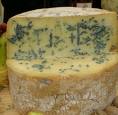
This blue is from the same manufacturer and is the same cheese except that is aged for a longer period of time, which makes it more crumbly and less creamy. It also has a stronger Taste. The Man prefers this cheese to the milder Dolce. The Picante version is wrapped in blue foil.
Source: Cow’s Milk
Kerrygold Blue.
New from this respected manufacturer of Irish cheeses, including Dubliner, a cheddar loved world-wide. Kerrygold Blue is a mild lemon-yellow cheddar with blue veining. It has been a wonderful addition to the Kiosk and The Lady likes to pair it with South African Peppadews from the Antipasti Bar.
Source: Cow’s Milk
Maytag Blue.
Vegetarian Suitable

By many, this is the “standard” by which all American Blue Cheeses are judged. The Lady disagrees. This cheese was developed in the early 1940s at the Maytag Dairy Farm near Newton, Iowa (home of the Maytag Corporation). Third and fourth generation members of the Maytag Family still own and run the Dairy Farm.
This cheese is made from homogenized milk, a process developed by two Iowa State University microbiologists in the late 1930s.
Source: Homogenized Cow’s Milk.
Roquefort.
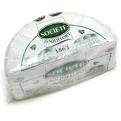
This cheese, by many, is THE blue cheese. It is made from sheep’s milk and is cave-aged. It is the first cheese in France to receive the AOC protection in the 1920s.
This cheese is chalky white, crumbly and moist. The veins of mold are a unique green color and the characteristic odor and flavor are from the butyric acid. The flavor has many layers. It starts mild, becomes sweet, changes to smoky and ends with a salty finish. The Lady claims that fans of Roquefort will not consider buying any other blue cheese.
From wikipedia.org, the following are the AOC regulations that govern the production of Roquefort cheese:
- All milk use must be delivered at least 20 days after lambing has taken place.
- The addition of rennet must occur within 48 hours of milking.
- The Penicillium roqueforti used in the production must be produced in France from the natural caves of Roquefort-sur-Soulzon.
- The salting process must be performed using dry salt.
- The whole process of maturation, cutting, packaging and refrigeration of the cheese must take place in the commune of Roquefort-sur-Soulzon.
Source: Raw Sheep’s Milk.
Shropshire Blue.
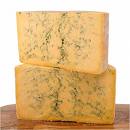
This cheese is made in England and is a cheddar cheese injected with blue mold. The Cheese Kiosk carries the version made by Long Clawson. This cheese was first made in the 1970s at the Castle Stuart Dairy in Inverness. It was originally called “Blue Stuart” but for some strange (and unknown) reason, it was marketed as “Shropshire Blue” despite the fact that is has no link, whatsoever, to the county of Shropshire.
The Man loves to melt this blue on his Angus Burgers rather than using the more standard faire of plain cheddar.
Source: Cow’s Milk
Saint Agur Blue.
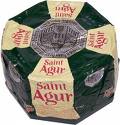
The cheese company Bongrain developed this cheese in 1988. In addition to the milk used to produce this cheese, it also is enriched with cream and contains about 60% butterfat. This qualifies it as a double cream cheese. This cheese is soft, creamy with a much more subtle and mild flavor than that of Roquefort. It also has olive green veins of mold. It also melts well in addition to being easily spreadable.
This cheese is a favorite of The Lady.
Source: Pasteurized Cow’s Milk.
Stilton Blue.
Vegetarian Suitable

This cheese is a EU PDO cheese. It is only manufactured in three counties of England and according to a very strict code. Only eight dairies are currently producing the cheese. The Cheese Kiosk carries the Stilton made by The Thomas Hoe Stevenson Dairy, which is a part of the Long Clawson Dairy Co-op.
According to wikipedia.org, in 1936 the Stilton Cheesemakers’ Association was formed to lobby for regulations to protect the quality and origin of the cheese, and in 1966 Stilton was granted legal protection via a certification trademark, the only British cheese to have received this status.
Bit of trivia about Stilton cheese. This cheese cannot legally be produced in the village of Stilton.
Source: Cow’s Milk.
Tholstrup’s Blue Castello.

This is a triple cream cheese from Denmark that was developed in the 1960’s. It has a fat content of 70% and its smooth, rich texture is similar to Brie, and other Triple-Cremes, especially Cambozola. The rind is washed like Brie and hosts various molds that add to the mild, spicy flavor.
Source: Cow’s Milk
Valdeon Blue.
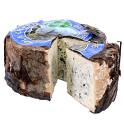
This is a Spanish Blue Cheese that The Lady does not like; but The Man is a big fan. And the reason is quite simple; it contains some goat’s milk and The Lady just doesn’t like it because…yep…you guessed it…”It’s too goaty!!”
Source: Cow’s, Sheep’s and Goat’s Milks
Serving Suggestions for Blues: The creamier blues spread well on bread, especially French Baguettes. Blues go well with fruit, especially pears. You can melt it; you can crumble it on salads; you can add it to salad dressings; you can cook with it.
Wine Suggestions: Blues stand up well with more robust wines and ports.
Follow me on: